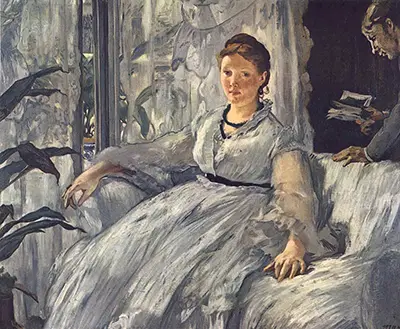Edouard Manet's painting style was innovative and varied, making use of different themes and styles across a vibrant oeuvre which remains highly respected by both academics and the general public.
Portraiture was frequent, Olympia amongst the most famous Manet paintings of all. Others would capture daily life in French cafes or small theatres, a lifestyle which still appeals internationally in the modern day. A Bar at the Folies Bergeres captures this type of French scene, whilst Le Dejeuner Sur L'Herbe provides an example of some of his work outside. Manet's enjoyment of colour can be found on several occasions in detailed, elaborate clothing such as in The Fifer. There are also horse racing scenes which remind us so much of Degas. In all, he wished to address all manner of different content within his work and would spend time in the company of other artists, where they would constantly exchange ideas and technical observations.
The portrait of Berthe Morisot makes use of large dark regions which goes against the impressionists with who he was strongly linked at that time. In truth, much of his work was indeed impressionist but he still preferred to distance himself from this group of artists in most cases. The rise of the impressionists and their popularity today has aided Manet's own reputation. Many will see him entirely as part of that group, but in truth he was more of a peripheral figure whose work had clear influences from them. In fact, most art movements over the centuries have been a loose collection of artists, some of whom have tended to sit more on the fringes, seeking to retain their own artistic independence.
Manet was technically highly skilled, and several innovations in his career were taken on by other members of the impressionist group. They would work collaboratively and exchange ideas, as well as exhibiting their work together. This is how Manet's Alla Prima technique, where colours are used directly rather than building through multiple layers of tone, would spread into the careers of his colleagues. It was an ideal way of capturing light which was essential to this movement. There were also other elements to his style which critics now look back on as having been exceptionally influential, marking him as the very first modern artist in the eyes of several respected academics. One needs to delve deeper into his technical work in order to understand this concept, where as most followers of his work simply appreciate the aesthetic beauty of his work and appreciate the different themes of content that he covered within a large oeuvre.
French art had an impressive history within the movements of Realism and Academic art, gifting us the likes of William-Adolphe Bouguereau, Gustave Courbet and Jean-François Millet from previous centuries. Many believe that Manet's legacy was to bridge the gap between these precise approaches with the more expressive style found within the Impressionist collective. He incorporated loose brushstrokes which was unusual for the time, though he received plenty of criticism in his early years as an artist, with some critics shocked by these new methods. Innovation within the art world have always taken time to receive acceptance, as a general rule, and examples of that go all the way back to when the Gothic style was superceded by the early stages of the Renaissance. It is also rare to see an artist whose best paintings were predominantly from the early part of his career, at least to some degree, and this underlines how he was technically skilled naturally and also that the bold ideas from his youth were the key to his success.



































































































































